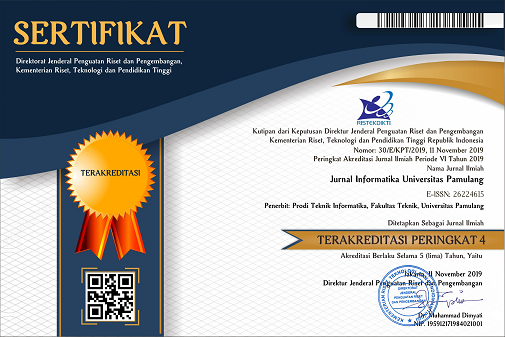Implementasi Data Mining Menggunakan Algoritma Fp-Growth pada Analisis Pola Pencurian Daya Listrik
DOI:
https://doi.org/10.32493/informatika.v6i2.12278Keywords:
Data Mining, Fp-Growth, P2TL, Electricity TheftAbstract
Electricity is one of the main needs that is most widely used by the community, both for household needs and industrial needs. Due to the large number of people's needs for the use of electricity, some consumers commit fraud or theft of electric power to reduce usage costs so that they are not in accordance with the recorded power consumption. Therefore PT. PLN Persero forms a team for Controlling the Use of Electricity or P2TL which aims to examine and take action to resolve the PLN installation or the installation of electricity users from PLN. The problem that occurs in this case is that in looking at the types of electric power theft that occur to customers who commit fraud, they still use the manual method, which is to determine the type of electricity theft that mostly uses catches through the official report, thereby slowing down the P2TL party to determine the target of operation or the type of violation. potential that often occurs in the Padangsidimpuan UP3 area. The purpose of this study is to build a website-based information system using the fp-growth algorithm data mining which aims to make it easier for P2TL parties to see how patterns of electricity theft that often appear, making it easier for officers to determine operating targets more quickly. This research uses the fp-growth algorithm with the stage of generating the conditional patten base, the stage of generating the conditional pattern tree and the stage of searching for frequent items. The results obtained from this study are the percentage value of the level of certainty of each item that appears so that it can be used as a reference in determining the type of electric power theft pattern that often appears using a website-based information system.
References
Ayu, F., & Permatasari, N. (2018). Perancangan Sistem Informasi Pengolahan Data Praktek Kerja Lapangan (PKL) pada Devisi HUmas PT. Pegadaian. Jurnal Intra-Tech, 2, 16–17.
Basalamah, L. W., Ransi, N., & Aksara, L. B. (2017). Implementasi Algoritma Frequent Pattern Growth pada Aplikasi Retail Berbasi Java Model View Controller (MVC). SemanTIK, 3(1), 67–80.
Ikhwan, A., Nofriansyah, D., & Sriani. (2015). Penerapan Data Mining dengan Algoritma Fp-Growth untuk Mendukung Strategi Promosi Pendidikan ( Studi Kasus Kampus STMIK Triguna Dharma). Jurnal SAINTIKOM, 14, No.3, 213–214.
Maharani, R. B. N., Nasution, M. I. P., & Triase. (2021). Sistem Informasi Payroll Pegawai dengan Absensi QR Code. Jurnal Informatika Dan Teknologi Pendidikan, 1, No.1, 23.
Nofriansyah, D., & Nurcahyo, G. W. (2019). Algoritma Data Mining dan Pengujian. CV. Budi Utama.
Sikumbang, E. D. (2018). Penerapan Data Mining Penjualan Sepatu Menggunakan Metode Algoritma Apriori. Jurnal Teknik Komputer, 4, No. 1, 156.
Suendri, Triase, & Afzalena, S. (2020). Implementasi Metode Job Order Costing Pada Sistem Informasi Produksi Berbasis Web. Jurnal Sekolah PGSD FIP Unimed, 4, No.2, 97.
Triase, & Samsudin. (2020). Implementasi Data Mining Dalam Mengklasifikasikan UKT (Uang Kuliah Tunggal) Pada UIN Sumatera Utara Medan. Jurnal Teknologi Informasi, 4, No.2, 371.
Zahrotun, L., Setiadi, T., & Mufti, T. (2018). Aplikasi Data Mining untuk Mencari Pola Asosiasi Tracer Study Menggunakan Algoritma FOLDARM. Jurnal Nasional Teknologi Dan Sistem Informasi, 01, 37–43.
Downloads
Published
Issue
Section
License
Authors who publish with this journal agree to the following terms:
- Authors retain copyright and grant the journal right of first publication with the work simultaneously licensed under a Creative Commons Attribution-NonCommercial 4.0 International (CC BY-NC 4.0) that allows others to share the work with an acknowledgement of the work's authorship and initial publication in this journal.
- Authors are able to enter into separate, additional contractual arrangements for the non-exclusive distribution of the journal's published version of the work (e.g., post it to an institutional repository or publish it in a book), with an acknowledgement of its initial publication in this journal.
- Authors are permitted and encouraged to post their work online (e.g., in institutional repositories or on their website) prior to and during the submission process, as it can lead to productive exchanges, as well as earlier and greater citation of published work (See The Effect of Open Access).
Jurnal Informatika Universitas Pamulang have CC-BY-NC or an equivalent license as the optimal license for the publication, distribution, use, and reuse of scholarly work.
In developing strategy and setting priorities, Jurnal Informatika Universitas Pamulang recognize that free access is better than priced access, libre access is better than free access, and libre under CC-BY-NC or the equivalent is better than libre under more restrictive open licenses. We should achieve what we can when we can. We should not delay achieving free in order to achieve libre, and we should not stop with free when we can achieve libre.
Jurnal Informatika Universitas Pamulang is licensed under a Creative Commons Attribution-NonCommercial 4.0 International (CC BY-NC 4.0)
YOU ARE FREE TO:
- Share : copy and redistribute the material in any medium or format
- Adapt : remix, transform, and build upon the material for any purpose, even commercially.
- The licensor cannot revoke these freedoms as long as you follow the license terms





